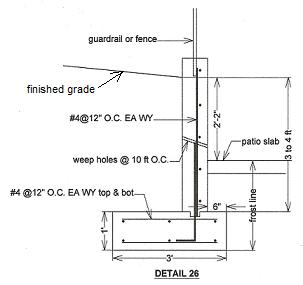ng
width of retaining wall depends on the height of the soil you need
retained. As shown below, the footing width is almost the same as the
height of the wall. The wider footing helps stabilize the wall when the
soil and water pressure start to buildup on the side of the wall.

Most retaining wall footings are at lease 12 inches thick and they all have rebar reinforcements on both top and bottom. As soil pressures buildup against the wall, the wall will lean towards the side with less soil, from detail 26, it will leans from left to right. This will cause the footing to bent downwards causing the top of the footings to be in tension thus the rebar on top.
Any load such as vehicles parking on the left side of detail 26 or a building built near the retaining wall just left of the stem wall will cause a lot of soil pressure against the retaining wall. This type of loading will require a much wider footing to resist. Should be the case in your project, you need to have a license structural engineer to design the stem wall and footings for you.
Retaining wall is one of the structures that require a licensed structural engineer involvement especially if its over 4 feet high. You might need to contact your local building department to find out retaining wall requirements in your area. From your local building department, they will be able to tell you the depth for the frost line shown in detail 26.
This price includes excavation of footings, 4'wall retaining wall with # 4 re bar 36" footings,drain,back fill. This is only a estimate we must submit engineered plans and address accordingly.

Most retaining wall footings are at lease 12 inches thick and they all have rebar reinforcements on both top and bottom. As soil pressures buildup against the wall, the wall will lean towards the side with less soil, from detail 26, it will leans from left to right. This will cause the footing to bent downwards causing the top of the footings to be in tension thus the rebar on top.
Any load such as vehicles parking on the left side of detail 26 or a building built near the retaining wall just left of the stem wall will cause a lot of soil pressure against the retaining wall. This type of loading will require a much wider footing to resist. Should be the case in your project, you need to have a license structural engineer to design the stem wall and footings for you.
Retaining wall is one of the structures that require a licensed structural engineer involvement especially if its over 4 feet high. You might need to contact your local building department to find out retaining wall requirements in your area. From your local building department, they will be able to tell you the depth for the frost line shown in detail 26.
BID PROPOSAL
TOTAL $12,800This price includes excavation of footings, 4'wall retaining wall with # 4 re bar 36" footings,drain,back fill. This is only a estimate we must submit engineered plans and address accordingly.
- Excavation - in addition to preparing the
actual wall, the property owner is going to have to consider the
excavation and site preparation required. Slope work is generally going
to come in at higher costs than work located on a level surface, but
according to the RSMeans cost calculation software, the following prices will apply:
- Clearing and grading of the plot - which tends to include brush and sod removal at a cost of $1800 per acre; and
- Materials - remembering that the project is going to require suitable backfill is essential and this will also have to be included in the costs of the project. This might include gravel and soil, or it could also mean the installation of drainage along with a gravel base and high-quality top soil. Costs will vary widely.
- The Wall - for a cast in place (concrete) retaining wall with a vertical face, installed on no more than a 33 degree slope with a level embankment, at 6' high (including excavation and backfill) the cost will be $12,800. When the wall is increased to 8' in height the cost will average at $13,700, and when the height is bumped up to 10' the cost increases to $19,900.
Additional considerations and costs
- Estimates and quotes - like many other major construction projects it is advisable to seek out estimates from a range of providers. Asking for references and going out to take a look at completed projects is a very wise decision. It is also a good idea to look at any walls following heavy rains in order to see if there is any trouble with drainage;
- The engineering - If the retaining wall is vital to the stability of a building lot it might also be necessary to seek the services of an engineer. This should not comprise any more than roughly 17% of any building project; and
- Dedicated DIY enthusiasts - if you are someone who is set on building a retaining wall, it is best to restrict the project to a very manageable size. For instance, something in the area of 20 linear feet at a height of 4' to 6' will be entirely possible. It will still require the same construction techniques, but it may be something that could use the more costly materials such as natural stone blocks, pressure treated lumber, and even bricks. Costs for this sort of project will remain lower than the professional installation with an average between $12 and $40 per linear foot.
No comments:
Post a Comment